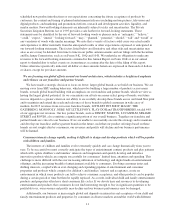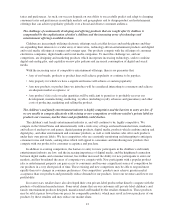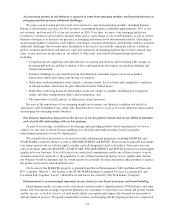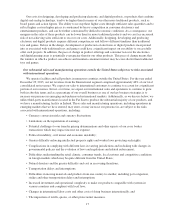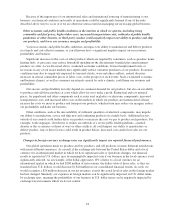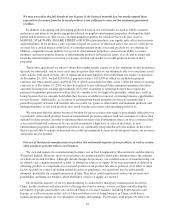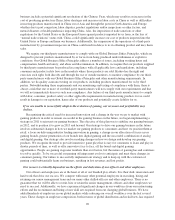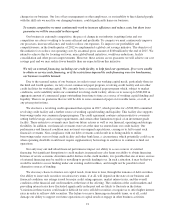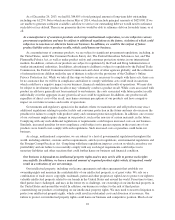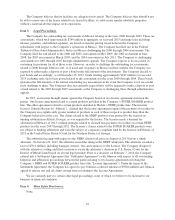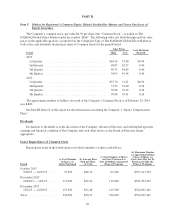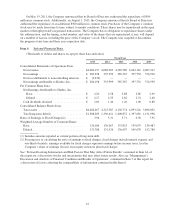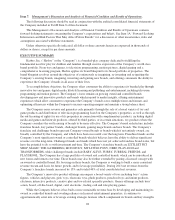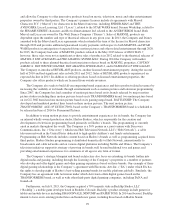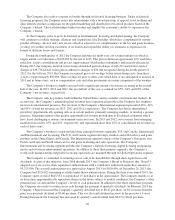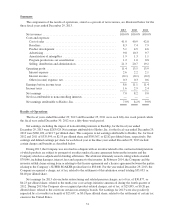Hasbro 2013 Annual Report Download - page 33
Download and view the complete annual report
Please find page 33 of the 2013 Hasbro annual report below. You can navigate through the pages in the report by either clicking on the pages listed below, or by using the keyword search tool below to find specific information within the annual report.changes in our business. Our loss of key management or other employees, or our inability to hire talented people
with the skill sets we need for our changing business, could significantly harm our business.
To remain competitive we must continuously work to increase efficiency and reduce costs, but there is no
guarantee we will be successful in this regard.
Our business is extremely competitive, the pace of change in our industry is getting faster and our
competitors are always working to be more efficient and profitable. To compete we must continuously improve
our processes, increase efficiency and work to reduce our expenses. To improve our profitability and
competitiveness, in the fourth quarter of 2012 we implemented a global cost savings initiative. The objective of
this initiative is to reduce our operating costs by an annual gross amount of $100 million by the end of 2015. We
intend to achieve this by focusing on fewer, more global brand initiatives, workforce reductions, facility
consolidation and other process improvements. However, these actions are no guarantee we will achieve our cost
savings goal and we may realize fewer benefits than are expected from this initiative.
We rely on external financing, including our credit facility, to help fund our operations. If we were unable
to obtain or service such financing, or if the restrictions imposed by such financing were too burdensome,
our business would be harmed.
Due to the seasonal nature of our business, in order to meet our working capital needs, particularly those in
the third and fourth quarters, we rely on our commercial paper program, revolving credit facility and our other
credit facilities for working capital. We currently have a commercial paper program which, subject to market
conditions, and availability under our committed revolving credit facility, allows us to issue up to $700,000 in
aggregate amount of commercial paper outstanding from time to time as a source of working capital funding and
liquidity. There is no guarantee that we will be able to issue commercial paper on favorable terms, or at all, at
any given point in time.
We also have a revolving credit agreement that expires in 2017, which provides for a $700,000 committed
revolving credit facility and a further source of working capital funding and liquidity. This facility also supports
borrowings under our commercial paper program. The credit agreement contains certain restrictive covenants
setting forth leverage and coverage requirements, and certain other limitations typical of an investment grade
facility. These restrictive covenants may limit our future actions as well as our financial, operating and strategic
flexibility. In addition, our financial covenants were set at the time we entered into our credit facility. Our
performance and financial condition may not meet our original expectations, causing us to fail to meet such
financial covenants. Non-compliance with our debt covenants could result in us being unable to utilize
borrowings under our revolving credit facility and other bank lines, a circumstance which potentially could occur
when operating shortfalls would most require supplementary borrowings to enable us to continue to fund our
operations.
Not only may our individual financial performance impact our ability to access sources of external
financing, but significant disruptions to credit markets in general may also harm our ability to obtain financing.
In times of severe economic downturn and/or distress in the credit markets, it is possible that one or more sources
of external financing may be unable or unwilling to provide funding to us. In such a situation, it may be that we
would be unable to access funding under our existing credit facilities, and it might not be possible to find
alternative sources of funding.
We also may choose to finance our capital needs, from time to time, through the issuance of debt securities.
Our ability to issue such securities on satisfactory terms, if at all, will depend on the state of our business and
financial condition, any ratings issued by major credit rating agencies, market interest rates, and the overall
condition of the financial and credit markets at the time of the offering. The condition of the credit markets and
prevailing interest rates have fluctuated significantly in the past and are likely to fluctuate in the future.
Variations in these factors could make it difficult for us to sell debt securities or require us to offer higher interest
rates in order to sell new debt securities. The failure to receive financing on desirable terms, or at all, could
damage our ability to support our future operations or capital needs or engage in other business activities.
21


